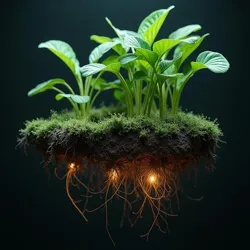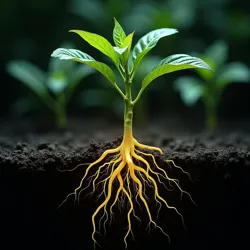Dark Agriculture
 A sophisticated hydroponic system utilizing engineered fungal networks for nutrient transport in complete darkness
A sophisticated hydroponic system utilizing engineered fungal networks for nutrient transport in complete darknessDark agriculture continues to revolutionize food production through groundbreaking innovations in lightless cultivation techniques. Recent advances in metabolic pathway engineering and deep troglomycology have expanded our understanding of plant growth in the absence of traditional photosynthesis.
Today's Featured Article: Piezoelectric Root Systems
The development of piezo-reactive materials has led to remarkable breakthroughs in energy generation within dark agriculture systems. These specialized root structures convert mechanical stress from soil movement and water flow into usable energy, creating self-sustaining growth environments. Recent research has demonstrated that these systems can generate up to 40% of the energy required for maintaining optimal growing conditions in subterranean farming complexes.
The integration of piezoelectric root systems with bespoke microbiomes has created unprecedented synergies in nutrient uptake and energy distribution. These hybrid systems demonstrate remarkable efficiency in resource utilization while supporting the development of novel crop varieties specifically adapted to lightless conditions.
Scientific Developments
Researchers at Hsiungonix Inc. have recently unveiled groundbreaking findings in the field of chemosynthetic plant metabolism. Their work on metabolic enhancement vectors has resulted in crop varieties capable of utilizing chemical energy sources previously thought inaccessible to plants, significantly expanding the potential of dark agriculture systems.
 Advanced imaging reveals the complex structure of chemosynthetic root systems in dark-adapted crops
Advanced imaging reveals the complex structure of chemosynthetic root systems in dark-adapted cropsStudies in substrate engineering have revealed new possibilities for creating optimized growing environments. The development of living soil matrices incorporates engineered organisms that actively maintain soil structure while facilitating nutrient exchange between plants.
Infrastructure Innovation
Modern dark agriculture facilities have begun implementing adaptive architecture systems that respond to plant growth patterns and metabolic needs. These dynamic environments utilize data from mycological communication networks to optimize growing conditions in real-time, leading to significant improvements in crop yields.
Nutritional Advances
The field of dark gastronomy continues to expand as researchers discover unique nutritional properties in dark-cultivated crops. Studies have shown that many plants grown in lightless conditions develop enhanced levels of beneficial compounds, contributing to both culinary innovation and global food security strategies.
Environmental Applications
The principles of dark agriculture have found surprising applications in bathymetric agriculture and deep-sea cultivation. These adaptations have opened new possibilities for food production in previously unsuitable environments, while contributing to our understanding of extreme environment biology.
Current Research Priorities
Scientists and agricultural engineers are focusing on several key areas:
-
Development of enhanced chemosynthetic pathways
-
Integration of bioelectrical systems
-
Optimization of nutrient cycling in closed systems
Technological Integration
Advanced monitoring systems incorporating biometric sensors and neural network analysis have revolutionized crop management in dark agriculture facilities. These systems provide unprecedented insight into plant health and development while optimizing resource allocation.
Sustainability Initiatives
The field of troglobotany has demonstrated remarkable success in developing closed-loop agricultural systems. These innovations have particular relevance for urban food production and space colonization efforts, where resource efficiency is paramount.
Cultural Impact
Dark agriculture has influenced contemporary approaches to urban planning and architecture, inspiring new concepts in subterranean urbanism and sustainable infrastructure development. The aesthetic and functional principles of dark agriculture have begun to shape modern design philosophy.
Educational Development
The growing complexity of dark agriculture systems has led to the emergence of specialized fields such as dark systems biology and chemosynthetic engineering. Educational institutions worldwide are developing programs to train the next generation of dark agriculture specialists.
Future Directions
Emerging research in quantum nutrient transport and bioelectric signaling suggests exciting new possibilities for enhancing crop productivity in lightless environments. These developments promise to further expand the capabilities of dark agriculture systems.
Safety and Monitoring
Advanced environmental control systems utilizing artificial ecosystem intelligence have improved safety standards in dark agriculture facilities. These systems maintain optimal growing conditions while ensuring worker safety and product quality.
Resource Management
The integration of symbiotic waste processing systems has significantly improved resource efficiency in dark agriculture operations. These systems utilize engineered organisms to maximize nutrient recycling while minimizing environmental impact.
International Collaboration
Global partnerships have accelerated innovation in dark agriculture technologies. The establishment of the International Dark Agriculture Consortium has facilitated knowledge sharing and standardization of best practices across borders.
Economic Impact
The dark agriculture sector continues to attract significant investment, driven by increasing demand for sustainable food production solutions. New markets have emerged for specialized equipment, engineered organisms, and consulting services.
The field of dark agriculture remains at the forefront of agricultural innovation, offering promising solutions for future food security challenges while pushing the boundaries of biological engineering and sustainable resource management.
Research Applications
Recent developments in rhizomatic consciousness have revealed new aspects of plant communication and resource sharing in darkness. These findings have led to improved understanding of crop arrangement and nutrient distribution in lightless cultivation systems.
The ongoing evolution of dark agriculture continues to reshape our understanding of plant biology and agricultural possibilities, promising innovative solutions for future food production challenges.